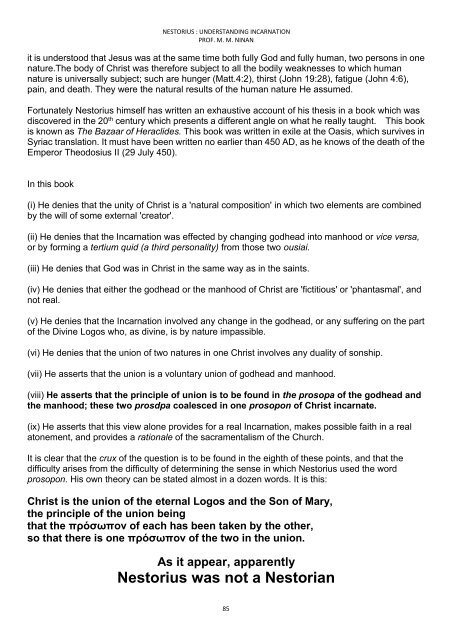Nestorius
You also want an ePaper? Increase the reach of your titles
YUMPU automatically turns print PDFs into web optimized ePapers that Google loves.
NESTORIUS : UNDERSTANDING INCARNATION<br />
PROF. M. M. NINAN<br />
it is understood that Jesus was at the same time both fully God and fully human, two persons in one<br />
nature.The body of Christ was therefore subject to all the bodily weaknesses to which human<br />
nature is universally subject; such are hunger (Matt.4:2), thirst (John 19:28), fatigue (John 4:6),<br />
pain, and death. They were the natural results of the human nature He assumed.<br />
Fortunately <strong>Nestorius</strong> himself has written an exhaustive account of his thesis in a book which was<br />
discovered in the 20 th century which presents a different angle on what he really taught. This book<br />
is known as The Bazaar of Heraclides. This book was written in exile at the Oasis, which survives in<br />
Syriac translation. It must have been written no earlier than 450 AD, as he knows of the death of the<br />
Emperor Theodosius II (29 July 450).<br />
In this book<br />
(i) He denies that the unity of Christ is a 'natural composition' in which two elements are combined<br />
by the will of some external 'creator'.<br />
(ii) He denies that the Incarnation was effected by changing godhead into manhood or vice versa,<br />
or by forming a tertium quid (a third personality) from those two ousiai.<br />
(iii) He denies that God was in Christ in the same way as in the saints.<br />
(iv) He denies that either the godhead or the manhood of Christ are 'fictitious' or 'phantasmal', and<br />
not real.<br />
(v) He denies that the Incarnation involved any change in the godhead, or any suffering on the part<br />
of the Divine Logos who, as divine, is by nature impassible.<br />
(vi) He denies that the union of two natures in one Christ involves any duality of sonship.<br />
(vii) He asserts that the union is a voluntary union of godhead and manhood.<br />
(viii) He asserts that the principle of union is to be found in the prosopa of the godhead and<br />
the manhood; these two prosdpa coalesced in one prosopon of Christ incarnate.<br />
(ix) He asserts that this view alone provides for a real Incarnation, makes possible faith in a real<br />
atonement, and provides a rationale of the sacramentalism of the Church.<br />
It is clear that the crux of the question is to be found in the eighth of these points, and that the<br />
difficulty arises from the difficulty of determining the sense in which <strong>Nestorius</strong> used the word<br />
prosopon. His own theory can be stated almost in a dozen words. It is this:<br />
Christ is the union of the eternal Logos and the Son of Mary,<br />
the principle of the union being<br />
that the πρόσωπον of each has been taken by the other,<br />
so that there is one πρόσωπον of the two in the union.<br />
As it appear, apparently<br />
<strong>Nestorius</strong> was not a Nestorian<br />
85

















